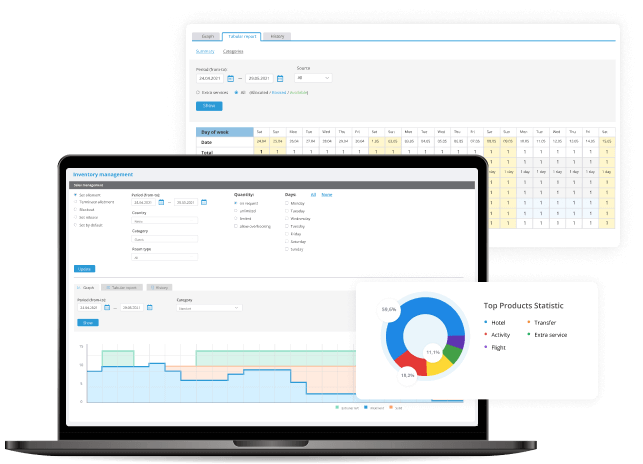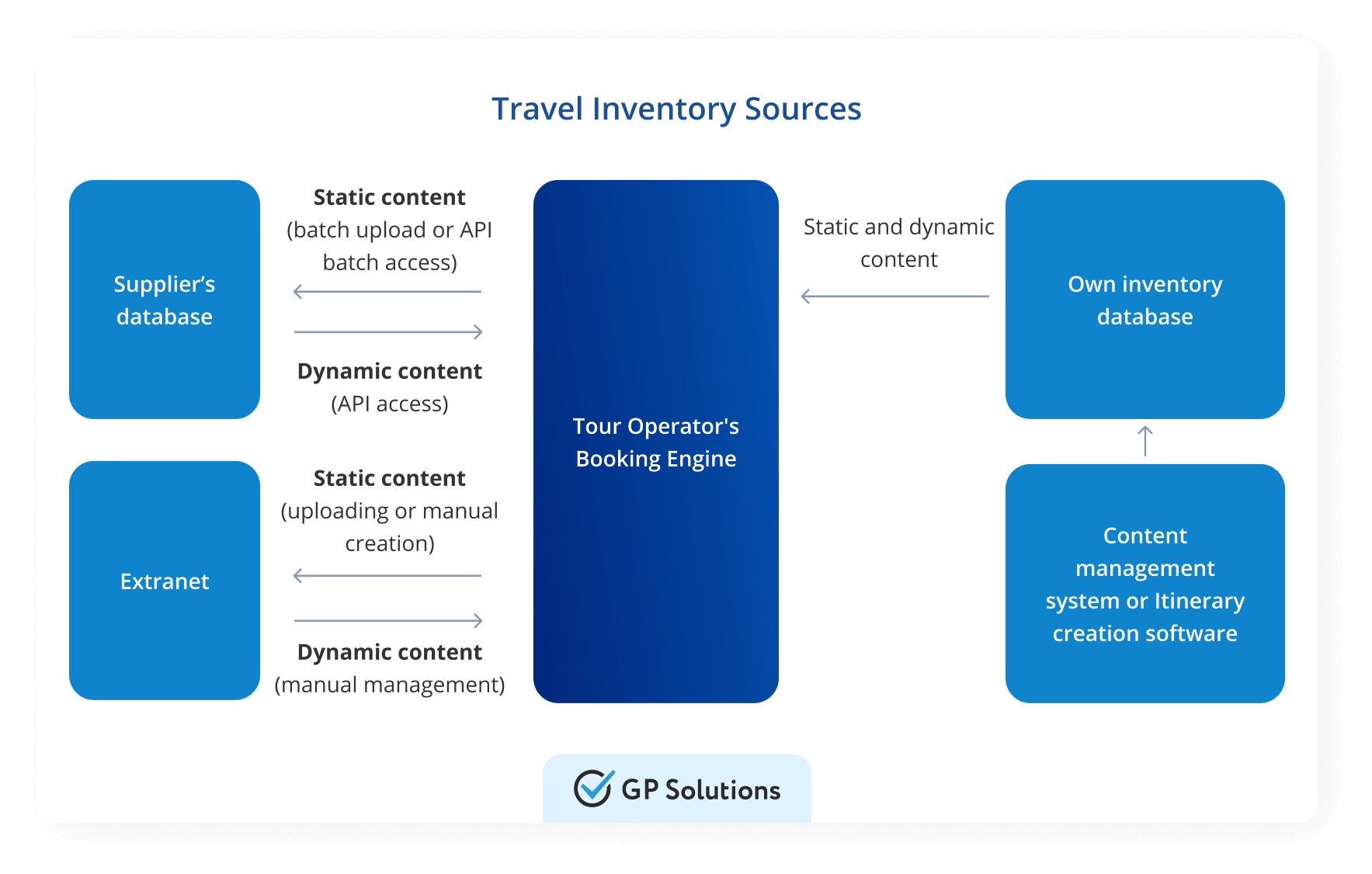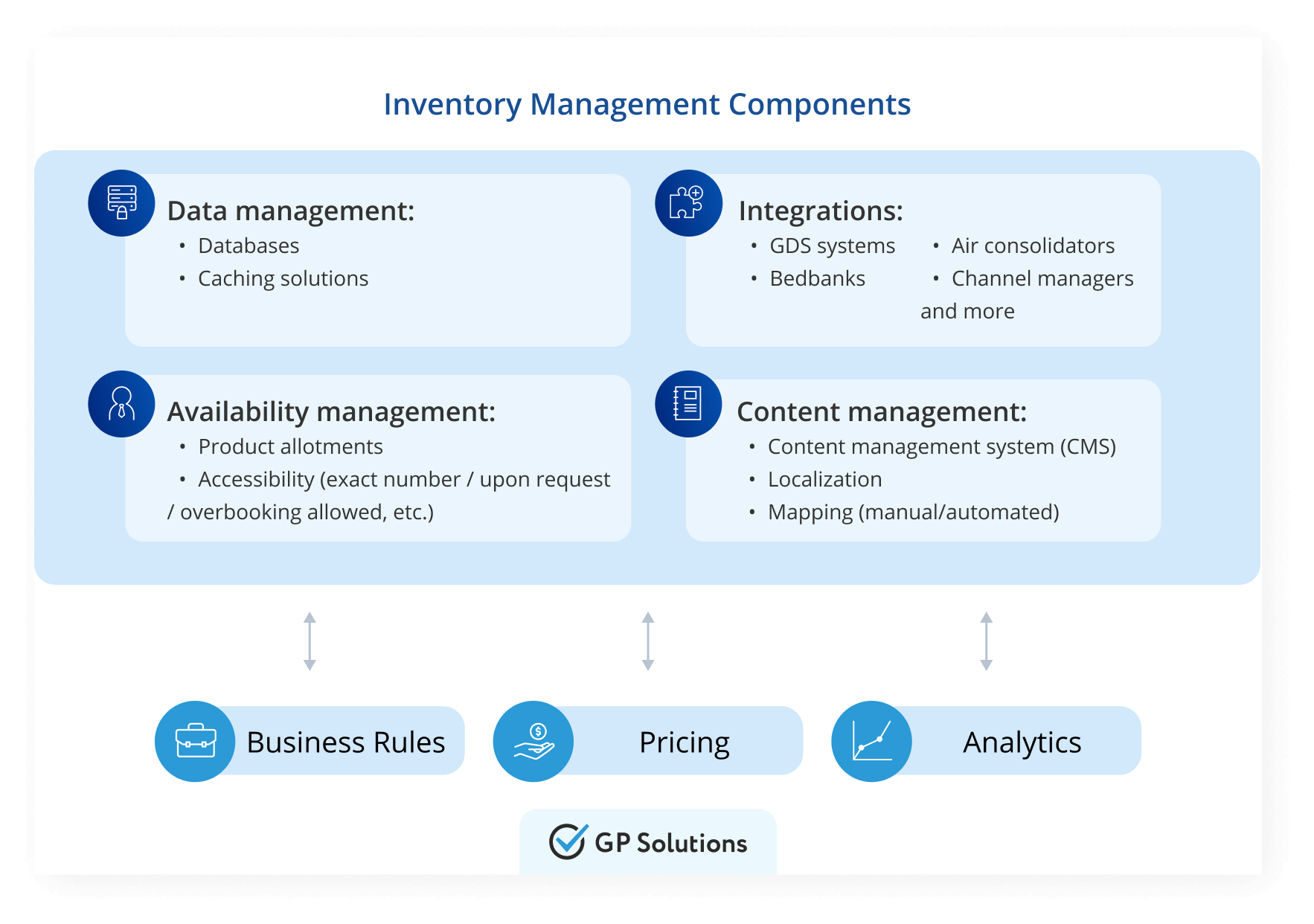
Modern tour operators make up for one of the key providers of travel products in the modern travel industry. Today, they can offer lots of sophisticated products and services using contemporary online technology. To make this happen, tour operators must have access to numerous suppliers and offer the latest travel information, including current rates and availability.
However, obtaining this information requires sourcing from multiple players in the travel market, each with their own unique conditions. To assist travel companies in making informed decisions, inventory software has become extremely essential for managing day-to-day operations.
Travel Inventory Management Solutions
When everything’s automated, your sales are only a click away

The primary focus of this article is to deal with the tour operator business model and how it approaches inventory management.
However, before going into any specifics, it’s important to get in terms with some basics of tour operator inventory management.
Tour operator inventory management systems encompass all the travel-related products distributed by various providers:
Despite the term “inventory” implying that tour operators own and store these products, they often source the product and content from 3rd-party supplier reservation systems. For example, an airline’s reservation system would store current seat availability, while a tour operator’s database would store static content (for example, hotel room descriptions and photos). Thus, the concepts of dynamic and static content are crucial with respect to inventory management.
When it comes to travel, there are two main types of content: dynamic and static.
Dynamic content is constantly fluctuating, including elements like pricing and availability. Tour operators typically don’t store this type of content, but instead access it in real-time from supplier reservation systems through APIs. While caching is an option, it’s not always utilized.
On the other hand, static travel content doesn’t change frequently and includes things like descriptions, photos, seat maps, and hotel amenities. This type of content is usually stored in an OTA’s database and can be purchased separately or accessed through an API and saved for future use.
This is the key issue that needs to be solved by every tour operator to ensure successful business operations. The range of available contracted suppliers define the revenue management, required technology and the business niche that is targeted by this or that tour operator.
Here is a principal scheme defining basic inventory operations for tour operators:

There are two general ways to access the necessary travel product content: direct supply and integrations.
Direct supply involves signing a contract with the exact supplier of the service you need to offer – a hotel, hotel chain, airline, car rental office, transfer service bureau, etc. An ideal way would be to have all these suppliers integrated directly with the respective tour operator back-office. This option would ensure real-time access to information like service descriptions, availability, and rates. And in case a customer decides to book a service, the reservation details are automatically transferred to the appropriate supplier.
However, building separate integrations can be costly and time-consuming, making it a viable option only for small- and niche-market operators. Additionally, some suppliers may not be willing to integrate directly. This situation creates the need for aggregators and other middlemen.
Bearing in mind the above, tour operators turn to various intermediary businesses depending on what inventory they might require. These middlemen, which can be Global Distribution Systems (the likes of Amadeus, Sabre, Travelport) or various wholesalers, are B2B companies aggregating travel product content from multiple end suppliers (e.g., hotels or airlines) and reselling it over to distributors – tour operators, travel agents, DMCs, OTAs, etc.

There are two basic scenarios linked to this approach:
In this case a tour operator and an intermediary supplier both sign an agreement which stipulates all the relevant legal conditions for cooperation, financials, rates and more. Then the process entails a two-way API-based integration for automatic import of inventory details upon request and sending back booking information in case a customer wants to place a booking request. This is the simplest cooperation format as the tour operator only deals with a single entity both in terms of contractual conditions and integration-wise. However, it is also less profitable since it does not allow negotiating better rates from the end travel product vendors.
Another way is to integrate with an intermediary on the technology side, but to also have direct agreements with the critical end suppliers of travel products. For instance, if your niche is to sell vacations in a specific destination (say, in Iceland), you can connect a hotel wholesaler and also arrange direct contracts with some key vendors providing accommodation, transfers, vehicle rentals and more.
Another option for larger Tour Operators is to develop an extranet – an internal system that allows end suppliers to manage their content and dynamic information. However, larger suppliers may not be willing to deal with manual extranet management, and small suppliers are likely to choose the largest distributors with the broadest market. While it’s possible for small local suppliers to work with small local distributors, it’s unlikely for larger chains like Hilton to manage their inventory on a mom-and-pop extranet.
Purchasing allotments from travel suppliers in large quantities and then bundling them into packages is another frequent scenario for tour operators. In this instance, they also keep all the inventory data on-site. End suppliers are typically manually informed about impending reservations, for example, by receiving a list of travelers and related data via email.
Now that we have a better understanding of the sources that fill in tour operator inventory, let us talk about efficient, modern inventory management approaches.
Modern tour operator back-office is a highly complex system, with inventory management being its constituent module responsible for acquiring inventory and organizing content. This process has many elements and challenges that we will deal with below.

Depending on where you get your inventory from, you need different technical solutions to store and display it.
Dynamic content. If you have your own inventory, you keep it in your internal system where you can control availability and prices and access it easily when customers search for it. A similar case is selling allotted or contracted inventory that’s uploaded and managed in your internal database.
If you receive dynamic content from an intermediary or a direct inventory supplier, you will usually need to build an API integration. With that said, many travel product suppliers charge a fee for each API transaction. So if you have many incoming look-to-book requests, it might be very expensive. Instead, you can consider creating a caching system that will save the most recent search results and only refresh the information occasionally.
Static content. As we mentioned, you can create a portal for suppliers to create and manage their static content (and often dynamic too). However, a more common scenario is buying it in batches (for ex., content like airport lists, hotel descriptions or airline logos) from specialized content providers. Anyway, it is kept in your system and shown to customers when they request for it.
If you have your own inventory, it’s important to showcase it well so that travelers choose you over competitors. Thus, tour operators typically use content management systems helping to create appealing descriptions, add images, adjust fonts, layouts, colors and make other design tricks.
Whether you sell your own or buy inventory, you have to keep in mind that you deal with international customers. This makes offering translated and customized content to be another efficient opportunity to stand out and create more value.
It also might happen that you receive the same travel product data from several suppliers. This is especially the case with hotel rooms and their descriptions. One and the same property may have a few tweaks in its content due to diverse naming practices that can be applied. As a result, travelers can see the same room twice (or more!) in search results with different names and descriptions. This issue can be solved using mapping techniques. This kind of work can either be done by a dedicated mapping provider or mapped by the tour operator.
Learn more about this topic in our dedicated hotel mapping article [here].
In this post, we have already emphasized the significance of seamless external integrations. However, it is equally critical to establish smooth data exchange with internal systems like pricing modules, booking engines or accounting tools. This ensures that your IT architecture functions efficiently without any data loss and minimized human effort.
These related modules are closely linked with inventory management, but generally form part of other tour operator back-office elements:

“Need help implementing tour operator software for your business? Let’s talk.”
Moving forward, we will delve deeper into the options of partnering with different intermediaries and aggregators, as they are the most common inventory sourcing scenario. Please note, we will describe the general operational concepts.
When it comes to flights, they form an indispensable part of tour packages provided by tour operators. This is especially true for outgoing operators focusing on sending travelers abroad. They can also sell flights as a standalone service, besides adding them to packages.
Tour operator businesses, especially established IATA-accredited companies, look for flight content in Global Distribution Systems (GDSs) – the likes of Sabre, Amadeus, and Travelport. Originally created by airlines to distribute flight inventory, GDSs now provide a wide range of travel products. They provide real-time information on flight schedules, availability, and rates from over 400 airlines. OTAs that integrate with GDSs negotiate direct agreements with critical airlines to obtain special rates.
For static content such as seat maps, GDSs are a reliable source. However, if OTAs want more information like airline logos or interior photos, they have to look for third-party providers.
New Distribution Capability (NDC) is a newer data exchange format that aims to replace the older EDIFACT protocol used by GDSs with a new XML standard. NDC enables direct connections between distributors and airlines, allowing for the sharing of rich content and the purchase of ancillaries such as extra baggage allowances or onboard Wi-Fi.
However, the main complication here is that tour operators / travel agents need to implement standalone integrations for every airline, which is in fact quite a challenge. An NDC aggregator like SITA or Farelogix can help out thanks to having established integrations with multiple airlines. While NDC is slowly being adopted by GDSs, its booking capabilities for agents are still underdeveloped. Many airlines also still do not support this standard.
Flight consolidators are intermediaries between airlines and travel companies. They offer access to unpublished, private fares that offer significant discounts ranging from 30 to 60 percent off retail prices. However, these fares cannot be publicly listed anywhere and must be advertised hastily or sold as part of a package. This requires travel agents to exercise caution while handling them.
Consolidators typically have contracts with major GDSs. The latter allow tour companies to use their credentials to access inventory and contracted rates. However, even if a tour operator has agreements with consolidators, it still needs a contract with a GDS to purchase inventory.
Large travel companies often have agreements with multiple consolidators to choose the best fare options. Additionally, discounted inventory from consolidators can also be accessed through GDSs.
When it comes to sourcing accommodations for tour operators, the options are as varied as the destinations they offer. From hotels to alternative lodging, the possibilities are endless. But where should OTAs turn to find the best deals and most reliable inventory?
One option is to utilize Global Distribution Systems (GDSs), which can act as a one-stop-shop for tour operators. However, while GDSs may provide a wide range of options, they may not always offer the best customer support. There can also be issues with too complex integration processes, insufficient documentation or lacking static content.
Key providers: Sabre, Amadeus, Travelport.
Another option is to work with wholesalers or bedbanks. These companies are engaged in purchasing rooms in bulk at discounted rates, which they further resell to interested buyers – tour operators, OTAs, DMCs, TMCs and other travel company types. Wholesalers often provide decent rates, strong coverage and connectivity, along with rich static content for presented properties.
Notable brands: Hotelbeds, WebBeds, HPro Travel, Travco, Bonotel.
For a more streamlined approach, tour operators can make use of channel managers – tech providers that hotels use to distribute their inventory across multiple channels. By connecting with a channel manager, travel companies can establish a close partnership with no extra middlemen and excessive commission payments.
However, it’s important to note that channel managers earn money from hotels. This means that they often may be reluctant to consider partnering with other businesses in the travel domain. More to that, it will be necessary to sign agreements with the relevant accommodation suppliers in order to sell their inventory. Also, many channel managers do not deal much with static content.
Notable brands: SiteMinder, Cloudbeds, RezGain, eZee.
No matter which route a tour operator chooses, the key is to find a reliable source of inventory that meets their unique needs and goals. There are indeed many options available and the world of travel is truly at their fingertips.
Integrating with multiple suppliers can be quite a headache, even when there is well-written API documentation at hand. Luckily, the travel market offers a range of APIs aggregation solutions. These systems aggregate a pool of suppliers and offer a unified API interface, allowing to plug into many of them with just one single integration. All the client needs to do is to provide relevant supplier API credentials. However, signing contracts with suppliers still needs to be handled by the tour operator.
Travel API Integration Services
450+ Integrations Completed
75+ Featured Suppliers
Multiple API types supported
Some aggregators go even further by offering mapping services, which merge pieces of content from different suppliers to avoid inconsistencies. These mapping specialists, also known as content providers, are crucial for tour operators that work with multiple vendors. By organizing their content and avoiding discrepancies, they ensure a smooth and seamless experience for travelers. In the world of hospitality distribution systems, connectivity and mapping are key components that enable tour operators to offer a wider range of options to their customers.
Aside from flights and accommodations, tour operators also make use of other types of inventory products, such as car rentals, cruises, rail tickets, and activities. However, sourcing these inventories can be a challenge.
For car rentals, Tour Operators can turn to travel industry giants or tech service providers that offer good conditions and integration-friendly APIs. CarTrawler, Travelopro, Trawex or eTravos are some great choices. These providers can offer access to a wide range of car rental options at competitive prices.
As for cruises, this is a smaller market. But still there are options through GDSs or aggregators that provide access to dozens of cruise lines and their static content.
Railways may be lagging in terms of digitization, but GDSs and aggregators like Trainline, Omio, Trawex, and TravelFusion Rail offer dynamic and static content, ticketing, and ancillary sales. These inventory sources can help tour operators offer a wider range of options to their customers for a seamless travel experience.
The world of tours and attractions (T&A) is full of various options for travelers: from classic sightseeing and group trips to quirky, personalized adventures. There is something for everyone. In order to access a rich and varied inventory of T&A products that can cater to any taste and preference, it makes sense to connect to a specialized reseller. These companies work with multiple suppliers and offer both information and booking options.
You can choose between two main ways of integration: becoming a partner or an affiliate (some platforms have both options). The difference is in how you handle the payment. As a partner, you have full control over the booking and payment process, acting as the merchant of record. As an affiliate, you only display the search results, but send the user to the supplier’s site for booking and payment.
Some leading T&A aggregators are Viator, GetYourGuide, Bokun, Musement, and Ticketmaster. By integrating with them, you can add the T&A search and booking (if you want to) functionality to your own product.
Technology is a must-have for running a business smoothly and effectively today. You can’t do without integrations, online presence, and smart analytics. And you need dedicated IT solutions to make them work. But how to run them properly?
Well, there is no simple answer here. There are software providers, of course that offer comprehensive off-the-shelf tour operator platforms with efficient inventory management. But the software still needs to be adjusted and customized to suit your specific needs. Thus, in addition to turnkey solutions, it might be a good plan to think about a custom inventory management system with all the right integrations and features. Such a solution can definitely boost your tour operator business stats, simplify operations and succeed on the market you’ve chosen.
Leave your request
We will contact you shortly
Thank you for your request!
We will get back to you as quickly as possible
Get latest insights
from our travel tech experts!
Join 200+ travel fellows! Get GP Solutions' latest articles straight to your inbox. Enter your email address below:
Thank You!